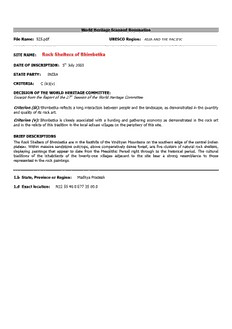
Rock Shelters of Bhimbetka PDF
Preview Rock Shelters of Bhimbetka
World Heritage Scanned Nomination File Name: 925.pdf UNESCO Region: ASIA AND THE PACIFIC __________________________________________________________________________________________________ SITE NAME: Rock Shelters of Bhimbetka DATE OF INSCRIPTION: 5th July 2003 STATE PARTY: INDIA CRITERIA: C (iii)(v) DECISION OF THE WORLD HERITAGE COMMITTEE: Excerpt from the Report of the 27th Session of the World Heritage Committee Criterion (iii): Bhimbetka reflects a long interaction between people and the landscape, as demonstrated in the quantity and quality of its rock art. Criterion (v): Bhimbetka is closely associated with a hunting and gathering economy as demonstrated in the rock art and in the relicts of this tradition in the local adivasi villages on the periphery of this site. BRIEF DESCRIPTIONS The Rock Shelters of Bhimbetka are in the foothills of the Vindhyan Mountains on the southern edge of the central Indian plateau. Within massive sandstone outcrops, above comparatively dense forest, are five clusters of natural rock shelters, displaying paintings that appear to date from the Mesolithic Period right through to the historical period. The cultural traditions of the inhabitants of the twenty-one villages adjacent to the site bear a strong resemblance to those represented in the rock paintings. 1.b State, Province or Region: Madhya Pradesh 1.d Exact location: N22 55 40.0 E77 35 00.0 Rock Shelters of Bhimbetka Continuity through Antiquity, Art & Environment A proposal for nomination for inclusion in the World Heritage List Archaeological Survey of India 1 2 A rare primary site, and one of the most ancient, Bhimbetka is a microcosm; a ‘living site’ set in its natural environment, as yet in its pristine state. Its vast and variegated content in one contiguous area provides great potential for comprehending the dynamics of the earliest settlements of man. That the area has also been able to sustain the ecological balances in relation to its natural environment gives an added dimension, one that has nurtured and supported cultural evolution and development over time. For archaeological evidences show an undisturbed continuous sequence of cultures through its layers from the Palaeolithic to the Historical periods; and on the visible surface, a rich profusion of paintings from the Mesolithic to the Mediaeval. Bhimbetka’s uniqueness lies not only in the concentration of its antiquity and art, and the wealth that it conceals, but that it has not remained frozen in time and space. Elements of this continuity are manifest in the creative expressions that show affinity to great antiquity in the traditional lifestyles of the adivasis of the area integral to Bhimbetka and the surrounding region. To preserve this site is of utmost importance. 3 4 Contents 1. Identification of the Property 10 - 11 a) Country 10 b) State, province or region 10 c) Name of property 10 d) Exact location on map and indication of geographical coordinates to the nearest second 10, 11 e) Maps and/or plans showing boundary of area proposed for inscription and of any buffer zone 11 f) Area of property proposed for inscription (ha.) and proposed buffer zone (ha.) if any 11 2. Justification for Inscription 14 - 44 a) Statement of significance 14 b) Possible comparative analysis 40 (including state of conservation of similar properties) c) Authenticity/integrity 43 d) Criteria under which inscription is proposed (and justification for inscription under these criteria) 43 3. Description 47 - 69 a) Description of property 47 b) History and development 54 c) Form and date of most recent records of property 60 d) Present state of conservation 61 e) Policies and programmes related to the presentation and promotion of the property 69 4. Management 72 - 85 a) Ownership 72 b) Legal status 72 c) Protective measures and means of implementing them 74 d) Agency/agencies with management authority 76 e) Level at which management is exercised (e.g., on property, regionally) 74 f) Agreed plans related to property (e.g., regional, local plan, conservation plan, tourism development plan) 79 g) Sources and levels of finance 80 h Sources of expertise and training in conservation and management techniques 81 i) Visitor facilities and statistics 82 j) Property management plan and statement of objectives 82 k) Staffing levels (professional, technical, maintenance) 84 5 6 5. Factors affecting the property 88 - 90 a) Development pressures (e.g., encroachment, adaptation, agriculture, mining) 88 b) Environmental pressures (e.g. pollution, climate change) 89 c) Natural disasters and preparedness (earthquakes, floods, fires etc.) 89 d) Visitor/tourism pressures 90 e) Number of inhabitants within the property, buffer zone 90 f) Other 90 6. Monitoring 92 - 94 a) Key indicators for measuring state of conservation 92 b) Administrative arrangements for monitoring property 94 c) Results of previous reporting exercises 94 7. Documentation 96 - 99 a) Photographs, slides and, where available, film/video 96 b) Copies of property management plans and extracts of other plans relevant to the property 96 c) Bibliography 97 d) Address where inventory, records and archives are held 96 8. Signature on behalf of the State Party 100 7 88 1 Identification of the Property 9
